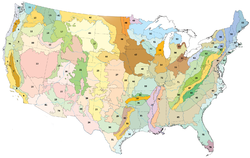




Wikipedia has articles relating to several ecoregion classification systems, defined by the conservation group World Wildlife Fund (WWF), the Commission for Environmental Cooperation (CEC), and like agencies around the world. The WWF uses three main classifications: Biogeographic realms (also called ecozones), biomes (also called major habitat types), and ecoregions. [1] [2]
Contents
- Global 200 ecoregions (WWF), 238 single or combined ecoregions identified by the World Wildlife Fund (WWF) as priorities for conservation.
- List of terrestrial ecoregions (WWF) 867 terrestrial ecoregions.
- List of marine ecoregions (WWF), 232 marine ecoregions of the coastal and continental shelf areas.
- List of freshwater ecoregions (WWF), 426 freshwater ecoregions.
- Lists of ecoregions by country
- Lists of ecoregions by continent